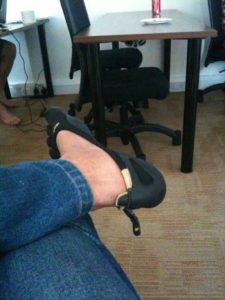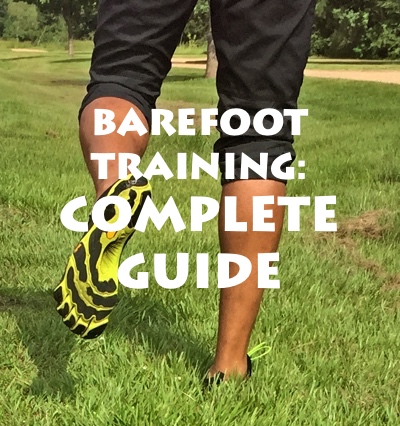Barefoot Training: Complete guide
Table of Contents
For years my clients have asked me the question: what is barefoot training? Is it safe for me? What is it all about? Can anyone go barefoot? This article will answer that question and more for you. The short answer is Barefoot training is partaking in any physical activity, sports or other endeavours with no footwear (barefoot) or some form of minimalist footwear. Now let’s take a closer look to give you the complete picture.
Barefoot or Minimalist
Let me start off by saying that the terms barefoot and minimalist are often used interchangeably today depending on whom you speak to, or what you read.
So, now I will walk you through the basics of this article.
- Barefoot – This is training in just your feet with no shoes at all.
- Barefoot shoes – Training in footwear with very thin soles that keep your feet close to the ground from heel to toe (zero drop), minimal cushioning at the heel, no arch support and a much wider toe box to give your toes plenty of wiggle room. Examples include Vibram five fingers and the Merrell glove check out the recommended gear page here.
- Minimalist shoes – These are in between running shoes and barefoot running shoes with a reduced heel-to-toe drop, less cushioning and little or no arch support. The toe box is typically in-between barefoot and traditional running shoes.
There are a few facts that have been well documented over the years to consider.
Here are some key things to know:
- Yes, anyone can do it if you start off slow and have the all the right advice and guidance
- Most shoes don’t do our feet and body any favours at all and inherently make our feet overly dependent on them for balance.
- Generally, our feet become weak from years of having artificial support from shoes.
- Under load from weight training or running, foot and ankle issues are more likely to occur.
- Improving Foot and ankle strength and mobilisation will set you up nicely to be successful in barefoot training.
- Everything is connected to everything: flexible; strong feet will aid optimal hip function and mobility and ultimately overall well-being.
- Preparation is everything: if you have always worn shoes then your feet will carefully need to learn to be barefoot first then you can progress to weight training, jogging and running
- Nature intended we move barefoot; the more physical activities you can do like this the better prepared your feet and ankles will be for those activities and life in general.
- It takes time
- Be patient
- Always consult your physician before you make any changes to your fitness regimen and practices.
What is the Ideal?
The ideal for me is simple: To get yourself to a level of fitness and mobility where you can tell your body to do any of the following: physical activity including weight training, walking, running, jogging, sprinting, yoga, bodyweight exercises, agility drills, etc. All of these, in barefoot or minimalist shoes. Once you achieve this, your feet and ankles will most likely be functioning as they should. Needless to say, all of this would preferably be done with proper form, no sharp pains or injury.
Where did it begin?
It all started more than ten years ago with the Fitness trends and research pointing to the numerous benefits of using our feet for what they were intended for. The follow-on was a flurry of barefoot and minimalist shoes flooding the market. We have everything from the no shoe movement to the inov-8s, Vibram five fingers, Merrell glove to name a few.
Since then the movement as it were has become more of a niche in recent years. In all instances, I would say common sense applies and if in doubt consult your Doctor.
How to start:
First, test your shoes out at home before you begin to wear them on a regular basis.
Common sense tells us starting gradually when beginning barefoot training. It should be a gradual approach. When I first went barefoot in 2010, I got a pair of Vibram Classic men’s five fingers and padded around the house until I got comfortable with the feel of the new barefoot shoes.
It takes a while for your toes and feet to get used to the new sensation of having material between them. I did this for about a month; we are all different, so see what works for you.
Do short walks and small errands to get used to the shoes
I did this then progressed to going on longer walks and more small errands around town to see how it felt. My feet felt a little sore as they began to get used to all the movement without the support of traditional shoes. However, I also started to need less and fewer breaks between wears as time went on.

Me in my five fingers in 2010
Do simple foot drills at home and in the gym
As well as walking barefoot when you are in the house or sitting at your desk, do simple calf raises as an example. You can also use any slightly elevated steps or platform to strengthen your calf muscles. You can stand on a lacrosse ball to roll on your foot arches, the balls of your feet and your heels to build strength. I go into a lot more details in my foot strengthening article here
Get the right Shoe
The Right show will have the following features:
- Wide toe box to give the toes wiggle room
- Little to no ankle support from the shoe
- Zero drop construction (heel is the same height as the forefoot)
- Flexible sole to allow the foot to flex naturally
- Minimal underfoot cushion, making the feet use its built-in shock absorption
Have a look at my post on how a Barefoot shoe should fit here
Do bodyweight exercises barefoot or with minimalist shoes on
Depending on where you work out and what the policies are I would suggest gradually building in the following drills a few minutes at a time to start.
- Calf raises
- To build your calf strength and in turn foot strength
- Deadlifts
- A Lower centre of gravity changes the dynamic of the lift
- Jumping Split Lunges
- Good explosive drill to aid foot strength
- Jumping Jacks
- Excellent as a barefoot warmup drill
- Short Sprints
- Good for building up foot strength
- Pushups
- Improves mobility of the feet, the range of motion and balance
As I said before start with a slow warm up, gradual progression is key
Add foot training to your routine
Your feet, ankles, and toes need to be trained just like any other body part. Moving to barefoot training in my view puts greater emphasis on the need for flexing, stretching, and strengthening your feet. When the muscles in your feet aren’t activating properly, or strong enough the tendons, ligaments, joints, and surrounding connective tissue are put under stress that it has not been used to before. have a look at my article on training drills that will help you strengthen your feet here
With over 100 different muscles, the feet and ankles make up 15-20% of all the muscles in the human body.
It stands to reason that the humble foot and ankles are meant to withstand incredibly high forces and loading. They should, therefore, be put in a position to deal with the loads and provide shock absorption to other parts of the body.
According to research by Dr Daniel E Lieberman entitled: The biomechanics of barefoot running.
“Before the introduction of modern padded running shoes in the 1970s, and for most of human evolutionary history, humans ran either barefoot or in minimal shoes. A comparison by Daniel Lieberman and colleagues of the biomechanics of habitually shod versus habitually barefoot runners now suggests that the collision-free way that barefoot runners typically land is not only comfortable but may also help avoid some impact-related repetitive stress injuries.
Kinematic and kinetic analyses show that modern shoes allow runners to land on the heel, as they do when they walk. Runners who don’t wear shoes land more often on the ball of the foot or with a flat foot. This means that they often flex their ankles as they strike the ground and generate smaller impact forces than shod, rear-foot, strikers compare the impact generated by landing from a jump on your heel versus your toes.”
The study goes on to say:
“One theory about barefoot lifting relates to the nerves that run throughout your body and signal your muscles to fire. The hypothesis goes like this: Your feet are the foundation for your body and, since they are rich with nerve endings that connect to other nerves up your legs and throughout your entire body, putting your feet to work could theoretically “turn on” extra muscle fibers throughout your body to help you move more weight and reap better calorie-torching, muscle-building benefits”
However, so far, the evidence is limited. For instance, one study out of East Tennessee State University found that
“when squatting barefoot, lifters activate some leg muscles to a greater degree than when they squat with shoes; however, this was only during the exercise’s lowering phase. They didn’t activate any extra muscle fibres when rising out of each squat”.
Potential downsides
The most significant drawbacks of barefoot training come with barefoot running because it puts the most considerable amount of impact on the feet out of all the other activities mentioned above.
Jumping straight into barefoot running typically will result in potentially all kind of injuries like plantar fasciitis, stress fractures and Achilles tendonitis. It cannot be overemphasised that most barefoot running-related injuries are merely due to doing too much too soon—or stepping on a sharp object.
Meanwhile, on the flipside, people performing barefooted parkour, yoga, pilates, or strength training, get injuries much less frequently, since, in these exercises, you are rarely loading your feet with more than your bodyweight. However, when you start picking up heavy things in the weight room, the excess load on the probably-not-so-strong muscles and bones in your feet can increase your risk of stress fractures.
Wrap up
You are reading this site, so you have quite a bit of information already
- Transition slowly, start at home
- Stretch and exercise your calves and Achilles tendon
- Don’t do anything that causes pain
- Listen to your body; we are all different: what works for one may not work for another
- Get a pair of Barefoot/ Minimalist shoes that meet your needs
- If in doubt consult a Doctor
To reap the rewards of barefoot training while minimising your risk of injury, start small.
